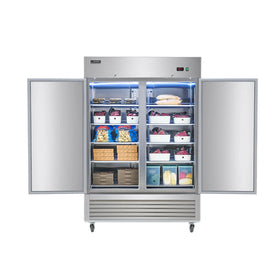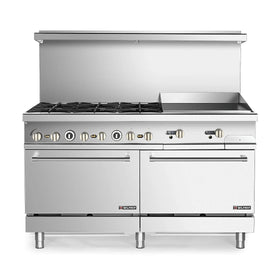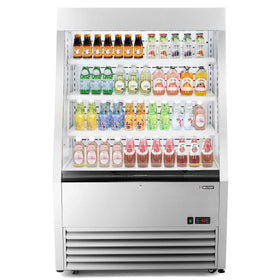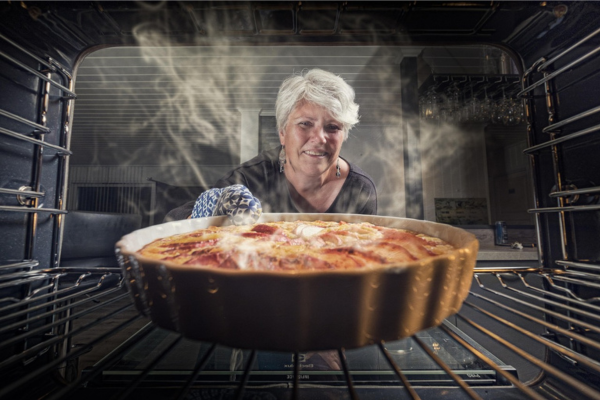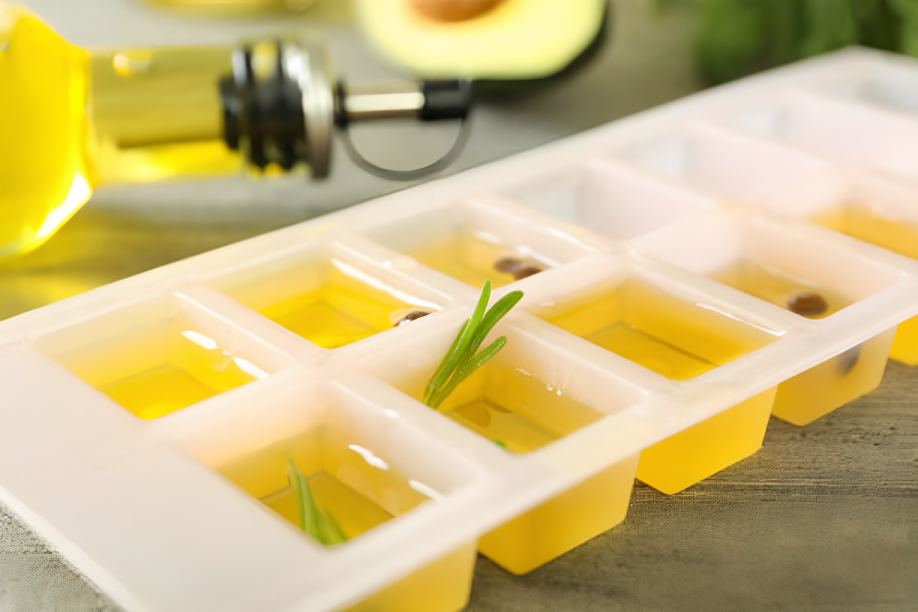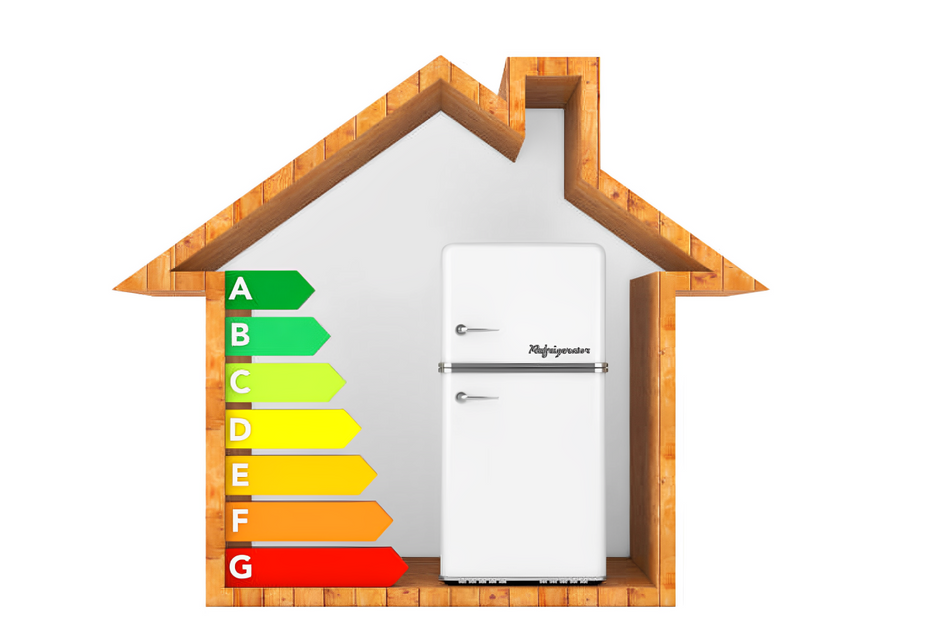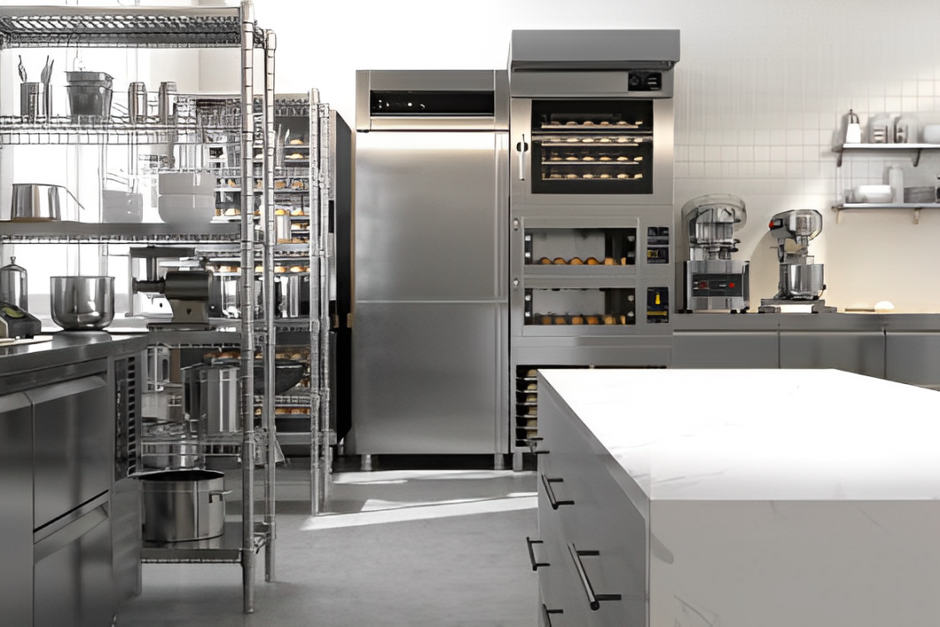Before tossing your favorite kitchen item into the oven, it is highly recommended that you always double-check if it can handle the heat. Using materials that are not oven-safe can result in a fire hazard, toxic fumes, or even shattering and explosions in severe cases.
In a commercial kitchen, this can be a big disaster, even if you are using commercial convection ovens, which are generally even quicker and more effective at heating large quantities of food.
In this guide, we answer the most important question for common items you might be tempted to put in the oven: Is it oven-safe? From aluminum foil to Pyrex glass and GreenPans, here’s everything you need to know.
Oven Safe or Not? Quick Reference Table
| Item | Oven Safe? | Maximum Temp | Notes |
| Aluminum foil | Yes | Very high | Don’t line the oven floor; safe on trays or for wrapping. |
| Parchment paper | Yes | 420–450°F (215–230°C) | Don’t use under the broiler. |
| Stoneware | Yes | Varies by brand | Avoid sudden temperature changes. |
| Pyrex glass | Yes (with care) | Typically 450°F | Avoid thermal shock. Don’t use on stovetops. |
| GreenPans | Yes | 420–600°F | Depends on the handle material; check the product label. |
| Silicone | Yes | ~428°F (220°C) | Not broiler-safe. |
| Clad pans | Yes | ~500°F+ | Watch for plastic handles. |
| Cooling racks | Sometimes | Depends on material | Use stainless steel only; avoid nonstick/chrome unless labeled oven-safe. |
| CorningWare | Yes | High oven temps | Avoid plastic lids and extreme temperature shifts. |
| Caraway | Yes | Pans: 550°F, Lids: ~400°F | Ceramic-coated lid may limit temp. |
| Tin foil | Yes | Very high | Same as aluminum foil. |
| Mason jars | No | N/A | Can crack/explode in the oven. |
| Snapware | Glass only | Varies (~450°F) | Plastic lids are not oven-safe. |
| Wax paper | No | N/A | Can melt or catch fire. |
| T-fal pans | Some models | 350–400°F | Handle material matters; check specs. |
1. Aluminum Foil
Aluminum foil is oven safe and widely used for baking, roasting, and wrapping food. However, avoid lining the bottom of the oven with foil, as it can reflect heat and damage heating elements.
Instead, use it on baking trays or to cover dishes to prevent over-browning.
If you are baking a pie, for example, you will likely need to use some aluminum foil.
2. Parchment Paper
Parchment paper is oven safe; you can put it in the oven-but only up to a certain temperature. Most parchment paper can withstand temperatures up to 420–450°F (215–230°C).
Never use it under the broiler or in direct contact with heating elements, as it may burn.
3. Stoneware
Stoneware is oven-safe and perfect for baking. It retains heat well and distributes it evenly. That said, it’s important to avoid sudden temperature changes, like moving it from the fridge straight into a hot oven, as this can cause cracking.
- Stoneware bowls are usually oven safe if labeled as such. If the bowl is intended for baking (like for casseroles, soups, or desserts), it’s designed to handle heat.
- Not all IKEA stoneware items are designed for oven use. Look for product info that says “microwave and oven safe”.
- Glazed stoneware is generally oven safe, but quality matters. Poorly glazed or cheaply made stoneware may crack if the glaze isn’t properly applied or fired.
4. Pyrex Glass
Yes, Pyrex glass is oven safe, and it is generally okay to put Pyrex glass in the oven. But be cautious: modern Pyrex is made from tempered soda-lime glass, which can still shatter if subjected to thermal shock.
- Pyrex glass bowls and Pyrex glass dishes are oven safe, as long as they’re labeled as “oven safe”.
- Pyrex mixing bowls are often oven safe, but check the bottom or product packaging to be sure.
- Pyrex glass containers are oven safe, but not the plastic lids. Remove all lids before putting Pyrex glass containers in the oven.
Pyrex-branded "glass Tupperware" is just another way to describe their storage containers. The glass part of Pyrex Tupperware is oven safe, but not the plastic lids.
Tip: Always preheat the oven before inserting a cold Pyrex dish, and never place it directly on a hot burner or cold surface after baking.
5. GreenPans
GreenPan cookware is generally oven safe, but the maximum temperature depends on the model. Most GreenPans can handle up to 420–600°F. Pans with stainless steel or silicone handles are usually safe for higher temperatures.
Always check your product’s label to be sure.
6. Silicone
Food-grade silicone is oven safe up to around 428°F (220°C), as long as you don't use it directly under a broiler. It’s great for baking molds, muffin cups, and liners.
Just avoid using it directly under a broiler, as extreme heat can degrade or warp it.
Related: How to Reheat Pizza in the Oven.
7. Clad Pans
Most stainless steel or aluminum-clad pans are oven safe up to 500°F or higher, but not all clad pans are safe to put in the oven.
If the pan has plastic or rubberized handles, those parts may limit its oven compatibility.
Double-check the manufacturer’s specifications before use.
8. Cooling Racks
Some cooling racks are oven safe, but not all. Stainless steel racks without a nonstick coating are typically safe to use in the oven.
Avoid using racks with chrome or nonstick coatings unless they’re specifically labeled oven safe: these can release fumes or warp under heat.
9. CorningWare
CorningWare is oven safe and built for baking and roasting. Whether you’re using classic or modern CorningWare, the ceramic glass construction can handle oven temperatures.
Just make sure to avoid extreme temperature changes, and don’t use the plastic lids in the oven.
10. Caraway Cookware
Caraway pans are oven safe up to 550°F. Their ceramic-coated aluminum construction is durable and heat-resistant enough to be used in the oven.
However, when putting caraway pans in the oven, be cautious with the lids, which may have a lower heat threshold (often around 400°F), and always refer to the product guide.
Related: Top Uses for Commercial Refrigerators
11. Tin Foil
Tin foil—more accurately called aluminum foil—is oven safe. You can use it to wrap food or line baking pans, but don’t let it touch the oven’s heating elements. Avoid lining the oven floor, as it can cause heat circulation problems.
12. Mason Jars
Mason jars are not oven-safe, and it is not advisable to put them in the oven. Though they can handle hot liquids for canning, they’re not designed to withstand the dry, intense heat of an oven.
Putting mason jars in the oven will cause them to crack or even shatter. They are not meant to be put in the oven.
13. Snapware
You can put Snapware in the oven, as long as you take off the plastic lids first. The glass part of Snapware is oven safe, but never put the plastic lids in the oven.
Snapware’s tempered glass containers can typically handle standard oven temperatures, but always check the model details to confirm limits.
14. Wax Paper
- Wax paper is not oven-safe. It’s coated with wax that can melt or catch fire in the oven.
- Use parchment paper instead for oven tasks, as it’s designed to withstand heat.
15. T-fal Pans
Some T-fal pans are oven safe—many up to 350–400°F, depending on the handle material. Metal handles can typically handle higher temperatures than plastic or rubber ones.
Be sure to check your specific model’s instructions for oven use.
How to Know if a Pan Is Oven Safe
Not every pan is designed to go from stovetop to oven. Here’s how to check if a pan is oven safe.
1. Look for an "Oven Safe" Label
Most cookware will say “oven safe” or include a max temperature on the bottom or handle, or in the packaging/manual.
2. Check the Material
As a rule, stainless steel, cast iron, carbon steel, hard-anodized aluminum, and ceramic-coated metal are usually oven safe.
- Avoid plastic handles or knobs, unless specifically marked oven safe.
- Nonstick pans can be oven safe, but usually up to 350–500°F, depending on the coating.
3. Examine the Handles and Lids
Metal handles are usually an indication that a pan is oven-safe.
- Plastic or rubberized handles are only safe if labeled as such, and usually only to lower temps (300–400°F).
- Glass lids are usually oven safe up to a limit (usually 350–400°F).
- Plastic lids are never oven safe.
4. Look Up the Brand
If you're unsure, search the pan’s brand and model online. Manufacturers usually list temperature limits and compatibility in the product details.
How to Tell If Glass Is Oven Safe
Glass bakeware can be tricky. Here’s how to know what’s safe:
1. Look for a Stamp or Label
Most oven-safe glass will be stamped with “Oven Safe,” “Heat Resistant,” or a temperature rating. Check the bottom or side of the dish or bowl.
2. Know the Brand
Pyrex, Anchor Hocking, and CorningWare make glassware designed for oven use.
Be cautious with dollar-store glass, drinkware, or decorative items—they're rarely oven safe.
3. Consider the Type of Glass
Tempered glass (like Pyrex) is heat-resistant but still vulnerable to thermal shock. Borosilicate glass (used in some European Pyrex or lab glass) is much more thermal-shock-resistant, but is not common in U.S. cookware anymore.
🚫 Never Use These in the Oven:
- Mason jars (even if labeled for canning)
- Glass drinkware
- Glass bowls are not specifically labeled for baking
Final Thoughts
Not all kitchen items are created equal when it comes to oven safety. Some, like parchment paper and Pyrex, are safe with limits, while others, like wax paper and mason jars, should stay out of the oven entirely. Always read product labels and use caution when cooking at high temperatures.
Check out these 5 convection ovens for a restaurant.


